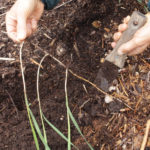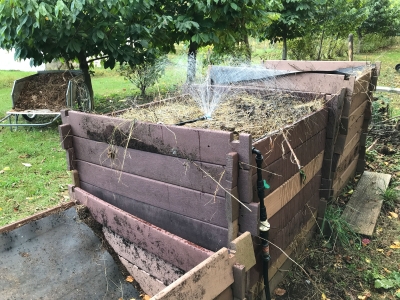Timing Gone Awry But Composting On Schedule
Time Change
Much of gardening is about timing — getting tomato plants in the ground early enough for a timely harvest, but not so early that transplants are killed by a late frost; checking that there’s enough time following harvest of early corn for a late planting of turnips, etc. So, when I began gardening, I read a lot and took lots of notes on what worked here in Zone 5, and eventually compiled everything into a neat table of when to do what.
I figured, with that table, that I was all set and would no longer have to respond to a gut impulse to plant peas during a freak warm spell in late February. Or to keep reading seed packets and counting back days to maturity to compute if there was still time, or it was too early, to plant a late season crop of endive.
Not so! In the few years I have gardened, which, though decades, is infinitesimal in geologic time, the climate has changed enough for me to have to shift those dates I so carefully figured out. No longer must I wait until the end of May to sow okra, squash, and other vegetables; the ground warms sufficiently to induce them to sprout a couple of weeks earlier now. No longer does a hard freeze strike tomato vines dead by the end of September. As I write, it’s the end of October and last night the first frost — a light frost — crept into the garden; later today, though, I’ll be picking ripe Sungold tomatoes.
Some perennial plants that, in the past, usually died back to the ground each winter, then resprouted in spring, no longer die back. Yellow groove bamboo, for instance. Nowadays their leaves stay green through most winters, which translates to taller and thicker canes. Crocosmia corms would hardly flower in years past; nowadays I don’t bother to dig up the corms, which flower and spread prolifically.
Taking Care of My Little Pets
Some things, gardenwise, are timeless or, at least, not time sensitive. The changing daylength throughout the year, for instance. And composting.
Although I feed my compost “pets,” that is, all the micro- and macroorganisms living and working the compost pile, all season long, this time of years those pets have a veritable banquet. In addition to the usual trimmings and scraps from the kitchen, beds are being cleared of corn, beans, okra, cucumbers, and all those other summer vegetables that are petering out.
I’m also having a lot of fun weeding. Yes, fun. Yes, weeding. (You might wonder why the author of the book Weedless Gardening has weeds. I grow a lot of fruit trees, shrubs, and vines, and some flowers, in addition to vegetables. I have too much garden. I can’t help myself. But everything is Weed-less.)
The ground has enough moisture in it so weeds are easily pulled. On my knees, I pull at a clump of Creeping Charlie, and creeping vines extending for 2 feet in all directions move up and out of the ground. I grab a clump of quackgrass and, if I lift carefully, a couple of feet of its creeping rhizome that attempts to extend its reach releases from the ground.

All this goes into the compost pile along with some horse manure and bedding, some hay I scythe from my field, and occasional sprinklings of soil and dolomitic limestone. As I layer these materials, I pay attention to their ratios of carbon and nitrogen, the two main feedstuffs of my compost pets. Old plants are relatively richer in carbon, young ones in nitrogen. Manure is rich in nitrogen, the bedding (wood shavings, which is old plants) in carbon. Too much carbon, and decomposition is sluggish. Too much nitrogen, and the pile gets smelly.
I also consider how fast ingredients might decompose. Wood shavings, for instance, are high in lignin, which slows decomposition no matter what their ratio of carbon to nitrogen.
The Little Guys Are (Usually) Thirsty
Two things that often slow composting are heat loss and insufficient moisture. Small compost piles lose too much heat; the critical mass for good heat retention is about a cubic yard. The bins into which I pile ingredients insulate the edges to further retain heat.
A lot of water is needed to seep way down into a pile. Rather than keep trying my patience holding a hose wand, a couple of years ago I purchased a small sprinkler and attached it to some plastic pipe so it fit neatly on top of my compost pile. A pressure regulator (usually used for drip irrigation systems) keeps incoming pressure constant so I could adjust an inline valve to make the spray consistently reach just to the edge of the pile. Twenty to thirty minutes gives my compost pets a good drink.
A long-stemmed compost thermometer is my final check that all is well. The piles typically reach 150°F. Compost piles don’t need to get that hot; more time composting also does the trick. Any pile of organic materials eventually becomes compost..


Lee, I stumbled on your website this morning looking for ideas about no-tilling and composting. What a great website! I have recently moved away from tilling my garden beds after running across an old soil fertility textbook that warned about the very large amount of soil carbon loss from tillage. I thought about why I was digging, let alone double-digging. I had a long held belief that I was doing good for my soil because I was increasing macropores; but did my soil really need more macropores? Was my soil that compacted? My beds have been in for 10 years and I have never walked on them. I know you went through these questions 30 years ago and changed your approach. Impressive! Anyway, I am letting earthworms and other soil creatures create soil structure, not me with some misguided ideas that I can improve upon what nature does. Anyway, this fall, I decided to put leaves on my open garden beds, instead of in the compost bin. As you have noted in your postings, compost is great for controlling germinating seeds and plants. When I pull back the leaves I see germinating seeds that will never reach the light. I also see elongated growing bulbs (I have never been able to get rid of) reaching for the light to no avail. My question is, why bother with composting at all, when you can just place organic matter on the top of the soil let it decompose and move into the soil over time? Thanks for your thoughts. David.
I do mulch with leaves in some parts of my garden — beneath berry bushes and fruit trees. In the vegetable garden it would be very difficult to plant small seeds in a leafy mulch. Perhaps even large seed. The other downside to leaves in the vegetable garden is that the mulch would delay soil warming in spring so I would have to delay for too long spring sowings. Many years ago I would mulch my whole vegetable garden deep in leaves in autumn. In early spring I would remove all the leaves and put them in a pile. One the soil thoroughly warmed, sometime in June, I’d spread the leaves back in the garden, around the plants, to conserve moisture, add organic matter, and, in autumn, delay cooling of the ground.
Where can I find the slats that your compose bins are made of?
It’s artifical wood decking manufactured by Trex and a number of other companies. It’s sometimes called “composite decking.”